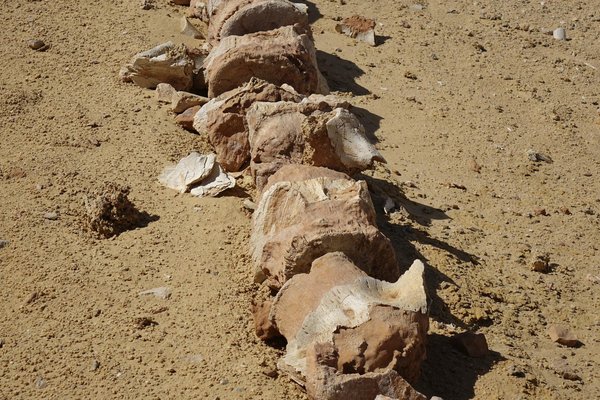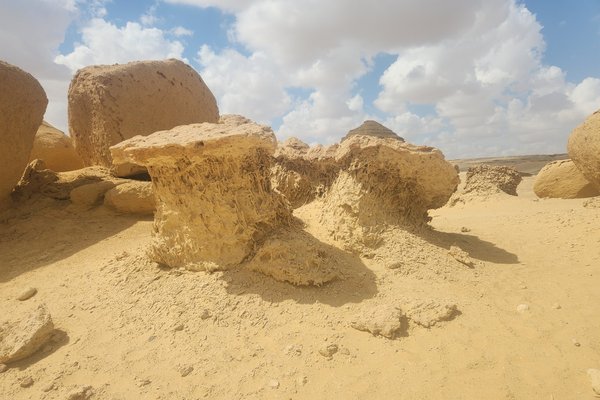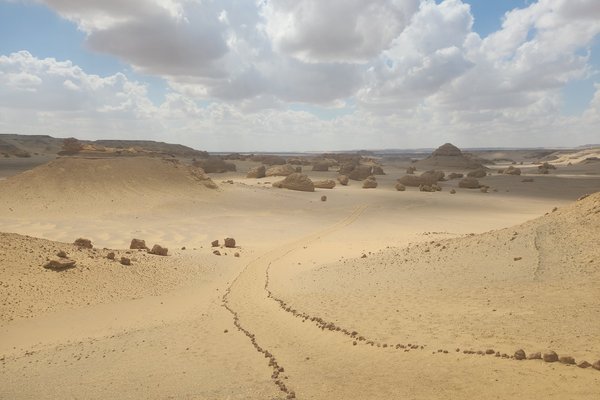Egypt
Wadi Al-Hitan
Wadi Al-Hitan (Whale Valley) is the largest and most important site in the world for whale fossils.
These fossils belong to a now-extinct subspecies of whales, which show their transition from land animals to marine mammals: they still have hind legs. The fossils have been found on the surface of the now completely dry landscape of the Western Desert, which was part of the enormous Tethys Ocean 40 million years ago. They comprise many complete skeletons and have been well-preserved in high numbers.
Community Perspective: it can be hard to reach as it is off-the-beaten-track and there may be police checkpoints along the way, but all reviewers managed to without issue (see Nan’s review for public transport options). Once on site, the fossils can be visited by following a signposted trail from the orderly visitor center.
Site Info
Official Information
- Full Name
- Wadi Al-Hitan (Whale Valley) (ID: 1186)
- Country
- Egypt
- Status
-
Inscribed 2005
Site history
History of Wadi Al-Hitan
- 2005: Inscribed
- Inscribed
- Type
- Natural
- Criteria
- viii
Links
- UNESCO
- whc.unesco.org
- Official
-
- fayoum.gov.eg — Fayoum Wadi El-Hitan
- Related
-
- www-personal.umich.edu — Research on the Origin and Early Evolution of Whales, by Philip D. Gingerich
All Links
UNESCO.org
- whc.unesco.org — whc.unesco.org/
Official Website
- fayoum.gov.eg — Fayoum Wadi El-Hitan
Forum Discussion
- worldheritagesite.org — Transport to Wadi El-Hitan
Related Resources
- www-personal.umich.edu — Research on the Origin and Early Evolution of Whales, by Philip D. Gingerich
News Article
- Dec. 12, 2019 phys.org — Newly described fossil whale represents intermediate stage between foot-powered and tail-powered swimming
- Jan. 16, 2016 egyptianstreets.com — Egypt Inaugurates Fossil Museum at Wadi El Hitan
- Aug. 27, 2007 int.iol.co.za — European diplomats in four-wheel-drive cars have caused extensive damage to a fossilised whale lying for millions of years in the Egyptian desert
Community Information
- Community Category
- Paleontology: Non-hominid fossils
Travel Information
Recent Connections
-
Perfect Inscriptions
2005 -
IUGS Geological Heritage Sites
Whale Valley, Cetacea and Sirenia Eocen… -
IUCN Green List
2018
Connections of Wadi Al-Hitan
- Geography
-
-
Sahara
Part of the Western DesertSee en.wikipedia.org
-
- Ecology
-
-
Whales
Fossil whale skeletons -
Dunes
sand dunes (UNEP-WCMC) -
Siraneans
Fossils include skeletons of sea cows (UNEP-WCMC) -
Sandstone Formations
-
Fossils
The globally important fossils of Wadi Al-Hitan (Whale Valley), in the Western Desert of Egypt, provide dramatic evidence of one of the iconic stories of evolution: the emergence of whales as ocean-going mammals, from their previous life as land-based animals. (OUV)
-
- World Heritage Process
-
-
Inscribed on a single criterion only
viii. to be outstanding examples representing major stages of earth's history, including the record of life, significant on-going geological processes in the development of landforms, or significant geomorphic or physiographic features -
Perfect Inscriptions
2005
-
- Constructions
-
-
Purpose Built Visitor Centre
Year unknown but after nomination file was written, core zone (see link)
-
- WHS on Other Lists
-
-
IUCN Green List
2018 -
IUGS Geological Heritage Sites
Whale Valley, Cetacea and Sirenia Eocene fossils of Wadi Al-Hitan -
Ramsar Wetlands
Wadi El Rayan Protected Area, 2012
-
- Timeline
-
-
Eocene
The rocks present at Wadi Al-Hitan are all Middle to Late Eocene in age (wiki)
-
News
- phys.org 12/12/2019
- Newly described fossil whale repre…
- egyptianstreets.com 01/16/2016
- Egypt Inaugurates Fossil Museum at…
- int.iol.co.za 08/27/2007
- European diplomats in four-wheel-d…
Recent Visitors
Visitors of Wadi Al-Hitan
- Alexander Barabanov
- Argo
- Atila Ege
- bergecn
- Bill Koo
- Boj
- Carlos Sotelo
- christof
- Christoph
- Christravelblog
- Cyberczar
- Daniela Hohmann
- Dirk-pieter
- DutchHorn
- Els Slots
- Errol Neo
- Evgenii
- Felicité
- Frédéric M
- henryjiao18
- Ivan Rucek
- Jawnbeary
- Jean Lecaillon
- Jens
- KarenBMoore
- Karito Vies
- Little Lauren Travels
- Loic Pedras
- Luis Filipe Gaspar
- marcel staron
- Martina Rúčková
- Michael Novins
- Michael Turtle
- Morodhi
- nan
- Peter Lööv
- Petteri
- Philipp Peterer
- Randi Thomsen
- Roger Ourset
- Roman Bruehwiler
- SnakeGreen
- Svein Elias
- Szucs Tamas
- Taotao Chen
- Tarquinio_Superbo
- Thomas Buechler
- Thomas van der Walt
- Vanessa Buechler
- Walter
- Westwards
- Wojciech Fedoruk
- Wo_ko
- Zoë Sheng
Community Reviews
Show full reviews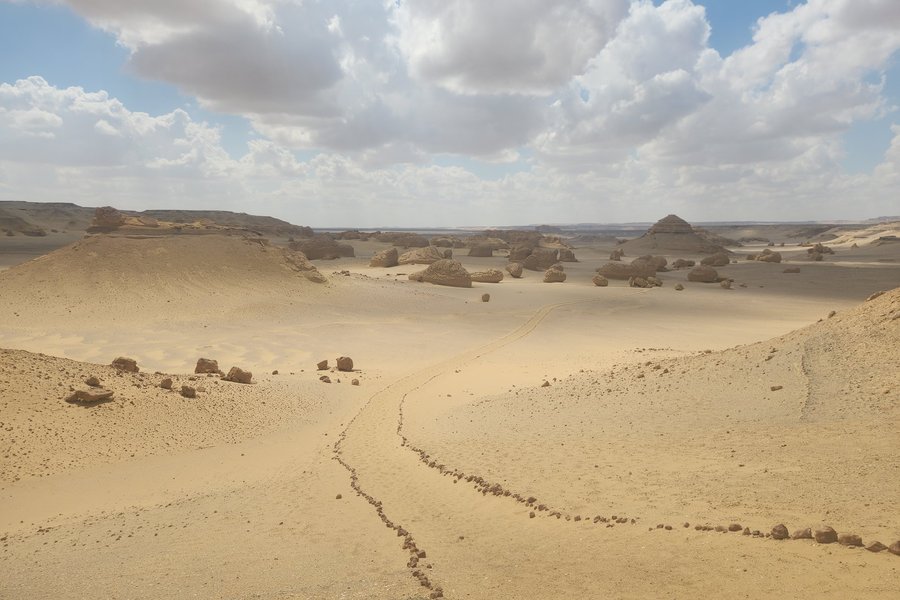
During my trip to Egypt in February and March 2025, I spent three nights at the Zad El Mosafer guesthouse in Tunis in the Fayoum and Lake Qarun region. I used Tunis as a base to visit Wadi Al-Hitan, Gebel Qatrani, and Soknopaiou Nesos. I organized all these activities through my guesthouse. What's more, they also arranged transport to Alexandria, with stops at the monasteries of Saint Pishoy and Saint Macarius the Great and Abu Mena.
My first day in Tunis was spent visiting Wadi Al-Hitan. The excursion organized by my guesthouse involved a driver taking me through the dunes to the site, followed by a visit to Wadi El Rayan. I started at the excellent little museum on the site. The museum tour begins with a video. You can then wander around the single circular room encircling two extremely well-preserved fossils of the two main whale species found at the site, the large Basilosaurus isis and the smaller Dorudon atrox. The museum clearly and effectively explains the geological and biological history of this part of the desert, and makes pertinent links with current climate disturbances. In my opinion, this is the best-designed museum I have visited in Egypt.
I continued with the trails into the valley. This part of the tour was very well described by Els and Nan. The scenery in the park is splendid. However, I was a little disappointed by the fossils. Wadi Al-Hitan is not Dinosaur Provincial Park or Joggins …
Keep reading 0 comments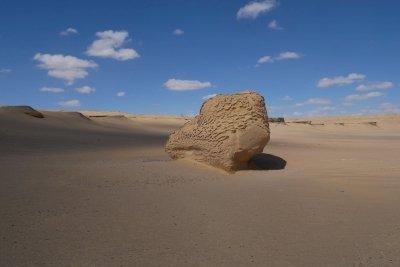
Egypt at it's core is two landscapes. The lush green strip of land land around the Nile. And the desert. At least nowadays. Going to Wadi Al Hitan, will take you outside the green strip inside the desert. But then, there they are: the whales. The explanation is that millions of years ago (40?), this was a mangrove forest.
It's a bit surreal and a very unique visit, as it combines a hike in the Sahara desert with stunning fossils. It feels almost like an art installation.
I had stayed the night in Tunis and joined a group of Egyptians (women) on a desert tour. We had plenty of time at Wadi Al-Hitan. The site has an onsite museum which I skipped and instead spent more time with the site proper. Most Egyptian visitors seem to stop fairly early on, but I kept going. Eventually, doubts settled in how far to go as I was all alone in the desert. But I think I made it to the end of the trail before returning. As pointed out by Els, you have to walk back the same way you came.
And one more comment: My mind seems to be off, but I didn't see mushrooms in the stones. ;)
Getting There
The starting point for most excursions to Wadi Al-Hitan is Tunis. Easiest option is to take a minibus from Giza to Tunis. They go right up to the park entry in Tunis with the option …
Keep reading 0 comments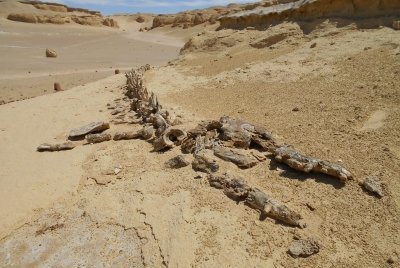
I visited this WHS in April 2017 on the day before leaving Egypt. I'm an amateur paleontologist and fossil collector, so visiting Wadi Al-Hitan was already in my plan besides seeing the ancient civilization. Since collecting Natural WHS is harder than the cultural one, I was determined to put this on my list as it's not too far from Cairo.
But it wasn't easy at all. Because I was traveling alone, all the travel agencies at the Tahrir Square could only put me in the waiting list for a bigger group. I was lucky when a group of 7 foreign students studying in Cairo University decided to join the tour. So we took off quite early in the morning as the journey to the first stop took a solid 3 hours. The first stop was a place with a lot of round rocks formation where they called it "watermelons". At this desert site you can clearly see the mark of ancient water flow. Then we went to the on site museum where you could see the evolution of the whale (Basilosaurus isis) where the small hind limbs still attached to the big body. The in situ fossils are just next to the museum with numbers along the path. Besides the whale fossils you can also notice a lot of sand dollar fossils around. In my opinion this is a very educational fossil site even for an ordinary person as one can imagine how the environment and life was long …
Keep reading 0 comments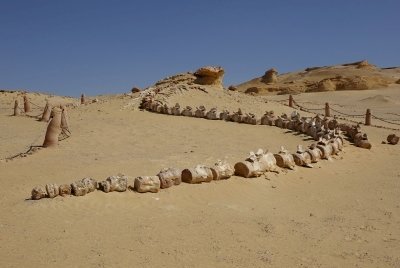
Wadi Al-Hitan (the Whale Valley) is “the most significant site in the world to demonstrate the evolution of whales”. The valley lies 190km south of Cairo in Egypt’s Al Fayoum area, to which the Dutch foreign travel advice still applies the label “necessary travel only”. Well – it was necessary for me! There is no reason to avoid this region nowadays. Large tour groups are assigned escorts according to the Lonely Planet – and indeed we met a tourist convoy of 4x4s accompanied by armed police. I was with a local driver (who seemed to know everybody) and we were just waved on at the only checkpoint near Lake Qarun.
In the early morning, I was picked up at my Cairo hotel with a 4WD jeep. Due to the busy traffic, getting out of (and into) Cairo is quite time-consuming. Once outside the city limits we hardly saw anyone anymore. The road has been completely paved up to the last 32km, but occasionally some sand hills have blown over the road and a 4WD (or just high clearance) is helpful. The final stretch is on a reinforced sand road. My driver found it more fun to drive off-road though. Some 3 hours after our departure we arrived at the Wadi.
This is one of the most modern and best-organized attractions in Egypt. There is a demarcated parking space, a café, clean toilets and a brand new museum. All these outbuildings are made in an adobe style so that …
Keep reading 0 comments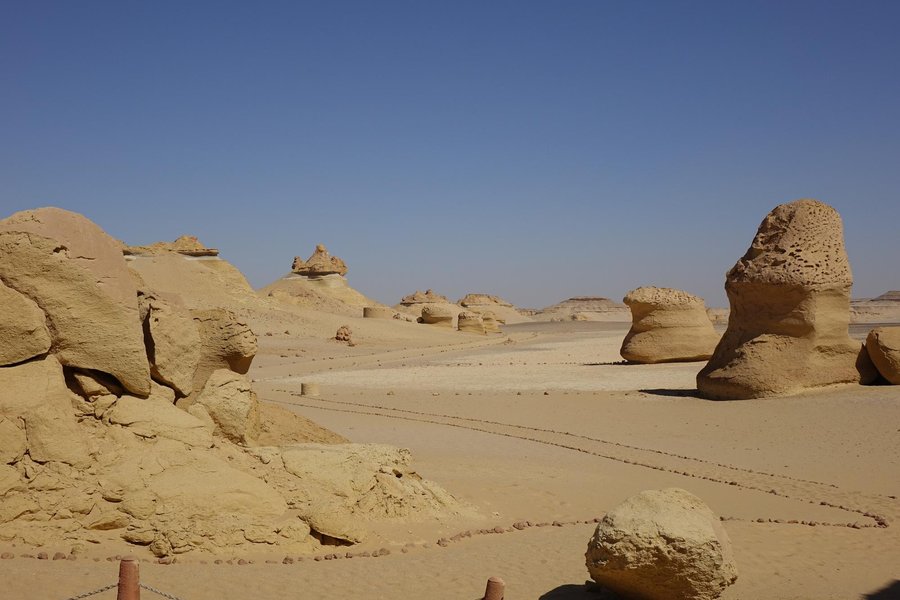
I'm from the province of Fayoum, which is located by the Valley Rayyan protected and which contain Whale Valley area. It's a great area with many old fossils, which reaches into the forty million years old. We welcome all those who want to visit this attractive place
Keep reading 0 comments
We drove to wadi al-hitan during our Egypt travel in February 2015. It was quite a drive from Cairo but great scenery on the way. It’s nice to drive through rural Egypt. The site is amazing with the skeletons and the views. I would recommend everyone to go here if you have the option. We did not camp ourselves (not so fond of camping) but I can imagine that’s a great experience too. Nearby there are some waterfalls too to explore. For in-depth photos have a look at my page.
Keep reading 0 comments
In 2008 was an undergraduate working on a dig at Karanis, an early Greco-Roman site about 50 miles outside of Cairo and Wadi Al-Hitan was one of the places where we made field trips out to study. It is, beyond measure, one of the most powerfully beautiful places that I have ever been to. The vast, echoing quiet and uniquely shaped landscapes were breathtaking. Trying to come to terms with the fact that 40 million years ago we would have been on the bottom of the ocean while in the middle of the Egyptian desert was both humbling and awe-inspiring. It is not a well-traveled site but is well looked after, and worth the side trip if at all possible.
Keep reading 0 comments
I went there with my son in July 2011, and if I read the elder reviews a lot has changed. I came with my own car and the road was, although not paved, reasonably good. It was a very hot day, we left very early in the morning from Tunis, but of course you are never early enough when the summer-sun is burning in Egypt. You do not need any police-permission anymore (anyway there is hardly police in Egypt after the revolution), you just buy a ticket before wadi el Rayyan. The first part of the road is passing sand-dunes and the lakes, beautiful!! The second part white sand, mostly flat, the white is burning in your eyes. There was only one person at Wadi Hitan, showing us where to start the 3 km long walk. We were very happy to walk on what was 40 million years ago the bottom of the ocean. Everywhere you see little or bigger sand-hills (over 6000), covering the fossile rests of all kinds of ocean-habitants. Fantastic. We were there all alone, if we were bad people we could have taken fossile vertebra's or ribs... (of course we are not). We loved the landscape so much! We were wondering who is taking the sand away after a sand-storm... We finished our walk at 10.00 h and that was just in time! I am advising you to go as early as possible in summer.
Keep reading 0 comments
We went in April 2010 and it is an incredible place. We went with an Egyptian Guide and Driver and arrived about 4pm, perfect timing as most visitors had gone so we had the whole place to ourselves and watched the sun setting and creating amazing colours on the surrounding rocks. Seeing the 40 million year old fossils and bones was incredible - the place is covered with mangrove fossils too. We then camped overnight there - waking up at 3am to see the moon up and looking out at such stunning scenery was something I will never forget. The highlight of our tour to Egypt.
Keep reading 0 comments
We went in October (2008) which was a perfect time of year with the afternoon sun showing off the rich colours of this pristine desert landscape. Once well inside the Wadi Al Rayan national park, there is a 35km dirt track at the end of which is a simple but orderly visitor centre for Wadi Al Hitan, nestled at the bottom of a cliff. From there a couple of short circular walks are laid out, along which fossils have been strategically laid. It’s very tastefully done however. The only trips available on the internet seem to be as part of expensive package tours but we hired a local to take us from the city of Al Fayoum. Make sure you leave before it gets dark and avoid in mid summer or if there has been heavy rain. Technically, all foreign tourists in Al Fayoum region should be accompanied by police for protection, but if you’re discreet it shouldn’t be necessary. Preferably travel with Egyptians.
Keep reading 0 comments
